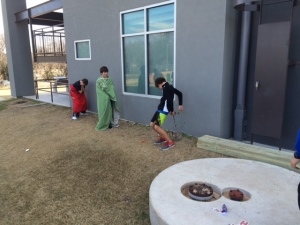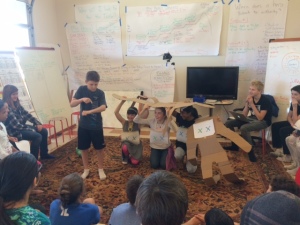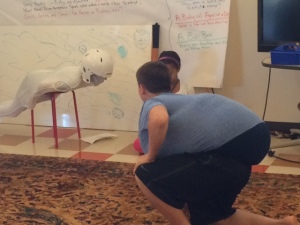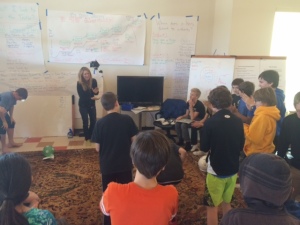Can you decipher these photos? A difficult challenge; to play the game, you’ll have to read to the end.
Your body has approximately 37 trillion cells. To put that into perspective, if each cell were a second, it would take over one million years to number the cells inside you. How many different types of cells do you think you could identify?
The challenge for Middle School Eagles in Week Two of the Biology Quest is to play detective, earning clues to decide which of the over 200 Cell Types and dozens of Cell processes have been assigned to their team.
All during the week, Eagles performed independent research, played games like Cell Craft (above) and wrote numerous short pieces about their discoveries, like this:
A cell is the building block of all living things including plants, animals, and, as you never would have guessed, single-celled organisms. Cells are made up of different parts, and vary from kingdom to kingdom, so I’ll go over the type that’s the most familiar to us animals, animal cells. Animal cells are made up of several components, all of which are crucial to the health of the cell. Let’s start on the outside, with probably the least complex of all of the parts of a cell, the cell membrane.
The cell membrane is basically a wall that keeps the good cell-parts in, and keeps the bad stuff out. (Or at least it tries to) Next up is the mitochondria. It’s the power plant of the cell. It produces adenosine triphosphate, or ATP, which is used to power the rest of the cell. The next item in our cellular journey is the nucleus, the center of the cell. The nucleus controls the cells functions, by controlling protein synthesis. The nucleus also stores the DNA, the instruction manual for the cell, and the nucleolus, which produces ribosomal RNA is produced.
Another organelle in the cell is the vacuole. It stores food, water, waste material, and a microscopic caveman named Bob. (I was kidding about that last one) Another part of animal cells is Lysosomes. They are the cell’s clean-up crew, breaking down food into smaller pieces, and they also break down old cell parts. Those are only some of the parts of the cell, with plenty more and more complex parts.
Completing each challenge earned another clue for your team. The sooner you received the clues and discovered your cell and cellular process, the sooner you could begin working on a skit to demonstrate your identity to the studio – without using any words. The team with the most correct guesses from the studio won.
Can guess the cellular processes and cells pictured above? Here’s a list of possibilities:
- Protein Synthesis (E. Coli.)
- Fertilization + Meiosis (Sperm)
- Photosynthesis (Plant Cell)
- Cellular Respiration (Fat Cell)
- Mitosis (Skin Cell)
Perhaps this video will help for one of the skits.
Here’s another:
By the end of the week, each Eagle had a deeper understanding of cells and cellular processes, and the week’s Launchpad Creator received the standing ovation pictured above from his Middle School comrades.
Quite an improvement from textbooks and lectures. All from a Quest created by a team of high school aged Eagles.





